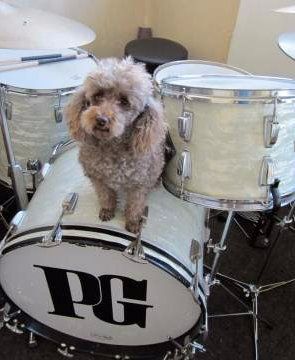Poodle Life Expectancy | Toy, Miniature, Standard
Overview
This section is dedicated to explaining the life span of the Poodle breed and to answer the questions of how long a Poodle will live.
We will go into detail regarding each variety: the Toy Poodle, Miniature Poodle and Standard Poodle.
While statistics are similar with the two smaller varieties, the Standard has a different life expectancy, and while all Poodles are vulnerable to certain medical issues, these will vary as well.
We will look at the top causes of death for each as well as important steps that you can take at home to extend the life span of your dog.
Why Size Affects Life Expectancy
One of the most puzzling aspects of life span in regard to canines is the 'old' concept that larger dogs have shorter life spans of smaller ones. However, this broad and general statement will be explained and specifically, how this relates to the Poodle breed in particular.
While statistics have proven this 'size affects life span' theory, animal biologists and other animal specialists have been taking a closer look to better understand this. It used to be widely believed that a larger dog's body had more work to do (pumping blood in a bigger body, etc.) however this can be debated since the bigger a dog is, the larger his heart. So, was this the only reason? It seems that the answer is 'no'.
Researchers in Germany have released a study after collecting data from over 56,000 canines - that included 74 breeds - and the results were a bit surprising. While they did conclude that larger breeds (i.e. the Standard Poodle) did have a longer life expectancy than small breeds (i.e. the Toy Poodle), data suggested that the larger dog's actually aged at an accelerated pace.
"Lives seem to unwind in fast motion" according to a biologist involved in the University of Gottingsen study. Therefore, it is not just a matter of the heart working faster, a large canine's entire body ages in 'fast motion' compared to a toy sized breed.
This in turn, means that many diseases (cancer, cardiovascular disease) will strike a larger dog years before a smaller dog would be vulnerable.
In addition, Musculoskeletal issues (joint problems, arthritis) and Gastrointestinal problems (pancreatitis, inflammatory bowel disease) tend to affect the larger Standard Poodle faster than it would affect the small, Toy Poodle.
And they were able to narrow this down to a specific time frame. Data showed that canines lose 1 month of life for each increase of 4.4 lbs. (1.99 kg). Keeping this in mind, it would suggest that a Toy Poodle on the smaller side - 6 pounds (2.72 kg) - may have a slightly longer life expectancy than a Toy Poodle on the larger side - 9 pounds (4.08 kg).
With all of this in mind, it must be noted that there are MANY exceptions. A tiny Toy Poodle can fall ill and life only 9 years while a large Standard Poodle may stay in excellent healthy well into his teens.
Life Expectancy For Each Poodle Variety
Life Expectancy For the Toy Poodle
- The median lifespan for is 15 years, with a range of 14 to 16 considered normal
Life Expectancy for the Miniature Poodle
- The median lifespan for is 15 years, with a range of 14 to 16 considered normal
Life Expectancy for the Standard Poodle
- The median lifespan for is 12 years, with a range of 11 to 13 considered normal
Life Expectancy for the Klein/Moyen Poodle
- The median lifespan for is 13.5 years, with a range of 12 to 15 considered normal
As you can see, both Toy and Miniature Poodles
have the same life expectancy, while the Standard Poodle does have a somewhat shorter life span. And the Klein/Moyen (a European size) falling in the middle.
Despite this general statistic, there are many Poodles of all different sizes that live well into their teens and it is not uncommon for a Poodle to live into his or her twenties. In fact, a well-documented case involves a Poodle born in 1908 that lived a long, happy life of exactly 28 years and 218 days, passing away in August of 1937.

KoKo, 8 years old
Photo courtesy of owner: Peter G.
Leading Causes of Death
An extensive study conducted by the University of Georgia which spanned 20 years, examined the causes of death of over 74 thousand dogs of all breeds. Here are the results:
Toy Poodle
- The leading cause of death by organ system was Neurological (16.1 %) and the 2 leading causes of death by disease were Trauma (11.7 %) and Cancer (11.4 %).
Miniature Poodle
- The leading cause of death by organ system was Neurological (13.9 %) and the 2 leading causes of death by disease were Cancer (18.5 %) and Trauma (10.8 %).
Standard Poodle
- The leading cause of death by organ system was Gastrointestinal (16.7 %) and the 2 leading causes of death by disease were Cancer (27.1 %) and Trauma (10.1 %).
Health Issues
Health issues
that commonly affect the Poodle breed -but are not necessary fatal - are:
- Addison's disease (not often fatal if caught early and proper medication and treatment is given)
- Gastric dilatation volvulus AKA bloat (can be dangerous fatal and most often seen in Standard Poodles, however with good feeding methods, exercise methods and knowing to look for early signs, can be treated in many cases)
- Thyroid issues
- Tracheal collapse (most common with Toy Poodles, not fatal in and of itself but can moderately to severely lower quality of life)
- Epilepsy
- Cushing's Disease
- Sebaceous adenitis
- Juvenile renal disease
- Hip dysplasia
- Bladder stones
- Cancer
Trauma
As you can see, a disturbing number of deaths of both the Toy and Miniature Poodle were related to trauma. Trauma encompasses any fatal injury to the body including polytrauma (affecting more than one body part), chest, abdominal and extremity trauma. For the Poodle, fatal trauma can occur in 1 of 3 ways:
1- Blunt force trauma:
This is a non-penetrating injury due to impact. For dogs, in most cases this means being hit by a passing car. There are also cases of dogs falling down staircases, falling off decks, being a passenger in a vehicle that is in an accident, etc. It is unfortunate that for all 3 varieties of Poodle dogs, this avoidable cause of death is responsible for at least 10% of cases.
2- Accidental trauma caused by humans:
Again, it is sad to say that especially for Toy Poodles and to a lesser extent, younger Miniature and Standard Poodles, accidental death due to being stepped on, dropped or in some cases, even being sat on! Again, in many cases these deaths could have been avoided.
3- Physical attack:
The 3rd category encompasses Poodles that receive fatal injuries when attacked by another dog.
The 2nd element to take note of is that cancer is among the top 3 leading causes of death for all types of Poodles and for the Standard Poodle, gastrointestinal issues at a top concern, which includes Bloat.
Ways to Help You Poodle Live a Long and Happy Life
It is sad that canines do not have life spans that are comparable to humans, since we consider our pets to be our family members and losing a dog is a heartbreaking experience. However, there are many steps that an owner can take to help extend the life span of the Poodle.
While these elements should be implemented when a Poodle is a puppy, it is never too late to start!
1- Feed Your Poodle the Healthiest Food Possible.
It cannot be overstated how terribly unhealthy cheap, manufactured food can be. Fillers, artificial coloring, artificial flavors and nasty preservatives are found in many. In worst case scenarios, the 'bottom of the barrel' of commercial dog food
can contain: Non-meat parts from chicken, pigs, sheep and cattle (this can include lungs, udders, tumors and diseased livers among other shockingly nasty elements), dead animals and "downers" (animals that were deemed too ill or injured to be slaughtered for human consumption).
Even with some very well-known manufactured brands, there are legal levels of contaminants that may not do much harm when ingested for a day… or a week…or a month. However, over the life span of your Poodle, here is a list of what could be building up in his/her system:
- Bacteria & bacterial toxins - Due to delays in animals being brought to the rendering plant, carcasses can become contaminated with Salmonella and E. Coli. While processing kills that bacteria, endotoxins are sometimes not completely eradicated and manufactured dog food is not tested for these.
- Mycotoxins - These are toxins from mold or fungi.
- Chemical Residues - Grains that are judged to have large levels of fertilizers and pesticides residue too high for human consumption can be legally used in dog food.
- GMOs- Genetically modified plant products that may cause liver and kidney damage.
- Acrylamide - A carcinogenic compound.
- Many brands contain preservatives (expected shelf life of dry dog food is 12 months due to high levels of preservatives). Worst is butylated hydroxyanisole (BHA) and butylated hydroxytoluene (BHT), propylene glycol and ethoxyquin. For these antioxidants, there is little information documenting their toxicity, safety, interactions, or chronic use in pet foods that may be eaten every day for the life of the animal. Propylene glycol is banned in cat food (it causes anemia) but it is still permitted in dog food.
Keeping all of this in mind, please choose a high quality food such as Orijen, Whole Earth Farms or opt for home cooking, remembering to be highly diligent to give your Poodle a full and complete vitamin and mineral supplement each day.
2- Be Aware of the Water that Your Poodle Drinks.
Many owners do not think about this element. Time to fill the dog's water bowl? Simply turn on the kitchen tap. But doing this can mean filling that bowl with nasty elements that can be very detrimental to the dog's health and potential shorten his or her life span. In MANY areas, there are legal limits of factory run-off, pesticides and bacteria found in tap water. Over the course of a Poodle's life, who knows what terrible effects these things will have and what diseases may result from years of ingesting them. Please play it safe and connect a filtering system to your kitchen tap.

3- Brush Your Poodle's Teeth.
Not only does tooth decay bring about the very real possibility of infection entering into the blood stream, when an older dog loses teeth or has decayed teeth, this lowers his quality of life. Also See: Dental Care
4- Exercise Your Dog.
A well exercised Poodle is a healthy Poodle! Dogs are not meant to live sedentary lives and daily moderate exercise
is strongly recommended. With this said, very excessive exercise can be harmful (strenuous walking during hot weather without breaks for water and rest in the shade, etc.) and particularly for Toy Poodles jumping from heights, etc. can lead to legs, knee, hip and/or back issues.
Regular exercise is extremely beneficial to all Poodles. In regard to emotional health:
- It helps a Poodle release pent up energy, which makes for a more relaxed, happy dog once back home
- Owners who take advantage of long walks to instill heeling commands and to incorporate socialization training will find that daily walks lead to a better-behaved puppy or dog, which can be looked at as improving quality of life.
There are many physical, health benefits as well. When a Poodle receives regular exercise, it helps to prevent:
- Stroke
- Heart disease
- Some types of cancer
- Arthritis
- Becoming overweight
With humans, exercise has been proven to aid in the growth of new brain cells and build connections between brain cells (essentially allowing one to learn at a faster, better pace) and there is some promising studies that point to this being true for canines as well.
5- Keep Regular Vet visits.
There are 2 staggeringly sad elements when it comes to veterinarian visits. The 1st is the sheer number of dog owners who do not bring their pet to the vet unless there is a serious issue. Many dogs have met an earlier death simply because an issue was not caught in the early stages when medical intervention would have saved the dog's life.
The other element is owners who hem and haw, unsure about what to do when their dog is ailing, injured or showing signs that something is wrong. When you take on the responsibility of having a dog, this means that you bring in a new family member - certainly a family member that deserves to be seen by a medical professional when there is a problem.
Arrange for yearly visits, keep up with follow-up visits and bring your Poodle puppy or dog to the vet (or at least call) if you have any doubts regarding his or her health.
If a vet does not seem to be running enough tests for a particular issue, if you feel that he/she does not do a good job of explaining issues or if you feel in any way that your Poodle would benefit from a different veterinarian, do not hesitate to obtain a second opinion or to change vets. Following these guidelines will certainly improve your Poodle's life expectancy.
6- Spay/neuter your dog.
There can be some debate regarding the issue of spaying and neutering, however it is overwhelmingly clear that spaying eliminates the chance of a female developing ovarian cancer - which is fatal in 50% of dogs - and decreases her odds of developing breast cancer. With males, neutering will eliminate the odds of developing testicular cancer (if done before the age of 6 months).
USA Today published a report that found that in states that have the highest rates of spayed and neutered dogs, those dogs also live the longest lives.
- Male dogs that are neutered live 18% longer than their unfixed counterparts.
- Female dogs that are spayed live 23% longer than their un-spayed counterparts.
7- Help Avoid Bloat .
Those with Standard Poodles will know the dangers of bloat (which is the 2nd leading cause of death for all large breeds and a deep concern for the Standard Poodle breed). Owners understand the importance of proper feeding, how to time exercise and so forth.
However, a professor of genetics at the University of Ottawa believed that bloat was caused by a dominant gene and came to the conclusion that 50% of Standard Poodles that had 1 parent that experienced bloat, would themselves develop this often fatal condition. More research must be done in this regard, however owners are wise to always follow feeding & exercise recommendations, as well as remain diligent in regard to noticing any potential early warning signs.
8- Prevent Trauma.
Since the study conducted by the University of Georgia (spanning 20 years) found trauma to be among the top 3 leading causes of death for Poodles of all sizes, taking steps to prevent accidents is a must.
Whether your older dog has never run away or your puppy appears to want to stay close, please do not take any chances. ANY time that your Poodle is outside the house without being in a safe, enclosure, he/she should be on leash. There should never be an exception. In addition, all members of the household - especially young children - should be taught how to properly handle a puppy
and these lessons should be repeated often.
Owners need to always be aware that a dog can swiftly move in their walking path and that even well trained dogs will have times of being curious and try to reach unsafe areas. Finally, being extra attentive when crossing the street with your Poodle or puppy or dog will go far in helping to prevent this avoidable cause of death that leads to so many Poodles to die at a young age.
When Is it Time to Let Go of an Ailing Poodle?
Approximately 25% of dogs die peacefully in their sleep; this means that for a large portion of the other 75%, owners will need to make an 'end of life" decision.
This is by no means an easy decision and it is at this time that it is suggested to look at quality of life. When an older, ailing dog is having difficulty breathing or is in near constant pain and medical intervention is unable to help, a brave owner will agree to take on the pain of losing his/her dog to allow the animal to be free from suffering.
A Final Note
Luckily, the Poodle has a relatively long life span and owners must never forget that they play a crucial role in both the quality of life and the life span of their dog by offering proper care at all times and maintaining the huge responsibility that comes with being a 'pet parent'.

